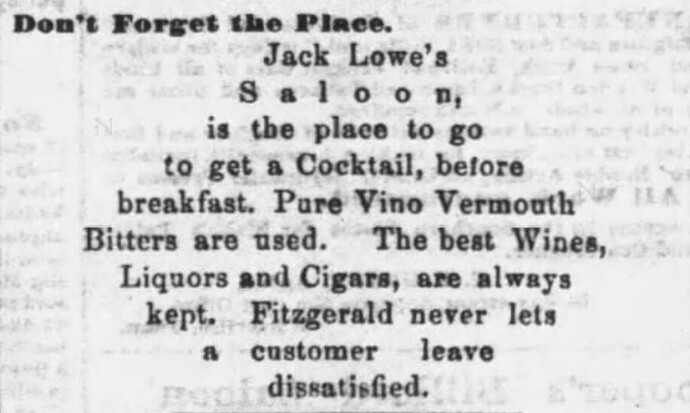Until a few weeks ago, the earliest known mention of the Martini was the “Martinez Cocktail” found in the Modern Bartenders’ Guide by O. H. Byron, whoever he was, published by the Excelsior Publishing House of New York in September, 1884. Unless, that is, you accept the pair of newspaper mentions from Cleveland and Chicago in 1883 discussing the Manhattan cocktail which define it as gin-based (you can find more about them here:
[The Coming of the Martini: An Annotated Timeline])
In May, however, I stumbled across an article in the Boston Weekly Globe from August 24, 1881 (page 7) titled simply “Mixed Drinks.” It’s a pretty standard “what the swells are drinking” article, with some reflections on the bartender and his craft. In the second paragraph, however, in a discussion of how drinks get named, we find the following lines:
Blockquote Thus it happens that there is always a goodly number of pet names to be called for at the bar, and that these in turn—save only the old staples—are not the same at different times but vary greatly in the course of years. Nobody knows who names them, but he must be an ingenious gentleman of an exceedingly original turn of mind. They have an article now masquerading under the startlingly facetious name of “Corpse reviver, J.W.P.”—the letters being the initials, undoubtedly, of the corpse which was originally revive by its administration. By far more gentle and soothing in its source is the appellation of another—“Sunday calm.” “Brandy smash” or “whiskey smash” have no reference to railway collisions, nor is there supposed to be any decoction of rooster’s feathers in a “martina cocktail.”
This is interesting for several reasons. One, it shows that, if parts of the country were still trying to figure out what to call this drink, the name it would eventually bear was already in circulation in 1881. Second, based on when they appear in print, it has always been assumed that the Manhattan, in print from August, 1882, was senior to the Martini (or Martinez, Martigny, Martena, Martine or, now, Martina–the spelling of the name was in flux for several years). Clearly that needs to be reexamined. Third, this is further evidence against the theory that the drink came from Martinez, California. But–fourth–it’s also evidence against the theory that the Martini was originally a New York drink. Boston was always considered a bastion of Martini drinking, and there may be more reason for that than we had assumed.
More proof that these matters are never really settled, and that there’s yet more gold in the archives waiting to be found.
